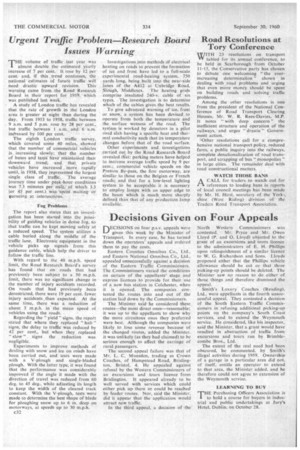Urgent Traffic Problem—Research Board Issues Wa rning T HE volume of traffic
Page 68

If you've noticed an error in this article please click here to report it so we can fix it.
last year was almost double the estimated yearly increase of 7 per cent. It rose by 12 per cent. and, if this trend continues, the national estimates of future traffic • will need • drastic upward revision. This warning came from the Road Research Board in their report for 1959, which was published last week. A study of London traffic has revealed that the rate of growth in the London area is greater at night than during the day. From 1953 to 1958, traffic between 9 a.m. and 5 p.m.. rose by 28 per cent., but traffic between 1 a.m.. and. 6 a.m.
increased by 100 per cent.
The eighth London traffic survey, which covered some 40 miles, showed that the number of commercial vehicles is. increasing slowly; that the number of buSes and taxis Have maintained their downward trend; and that private vehicles have increased .rmore rapidly until, in 1958, they represented the largest single class of .traffic. The average journey time under peak-hour conditions was 7.3 minutes per mile, .of which 3-3 or 45 per cent.), was spent waiting or aueueing at intersections.
. Fog Problems The report also states that an investigation has been started into the Possibility of guiding vehicles in dense fog, so that traffic can be kept moving safely at a reduced speed. The system utilizes a cable buried along the middle of the traffic lane. Electronic equipment in the vehicle picks up signals from this guidance cable, which help the driver to follow the traffic line. With regard to the 40 m.p.h. speed limit, the Road Research Board's survey has found that on roads that had previously been subject to a 30 m.p.h. limit, there was no significant change in' the number of injury accidents recorded. On roads that had previously been derestricted, there were 19 per cent, fewer injury accidents than expected. At the same time, there was a reduction of about 3 m.p.h. in the mean speed of vehicles using the roads. • Regarding the "yield "signs, the repott stated that where they repined " halt " signs, the delay to traffic was reduced by 42 per cent., but when they replaced " slow " signs the reduction was negligible. Experiments to improve methods of dealing with snow and ice on roads have been carried out, and tests were made with a V-plough and single-bladed plough. With the latter type, it was found that the performance was considerably improved if the angle it made with the direction of travel was reduced from 60 deg, to 45 deg., while adjusting its length to keep the width of the cleared track constant, With the V-plough, tests were made to determine the best shape of blade for ploughing snow up to 6 in. deep on motorways, at speeds up to 30 m.p.h. • Investigations into methods of electrical. heating on roads to prevent the formation of ice and frost have led to a fulkscale . experimental road-heating system, 750 . yards long, being built into the near-side lanes of the A412 at Uxbridge Road, .Slough, Middlesex. The heating grids comprise insulated 240-v, cable of six types. The investigation is to determine which of the cables gives the hest results. To give advanced warning of ice. frost or snow, a system has been devised to operate from both the temperature and the surface wetness of the road. The system is worked by detectors in a pilot road slab having a specific heat and thermal conductivity such that its temperature
• changes before that of the road surface.
Other experiments and investigations carried out by the Road Research Board revealed tliat: parking meters have helped to increase average traffic speed by. 9 per cent.; commercial vehicle speeds on the Preston By-pass, the first motorway, are similar to those on the Belgian or French roads; and that for a low-level lighting system to be acceptable it is necessary to' employ lamps with an upper .edge to the beam which is muck more sharply defined than that of any production lamp available.
























































































































































































